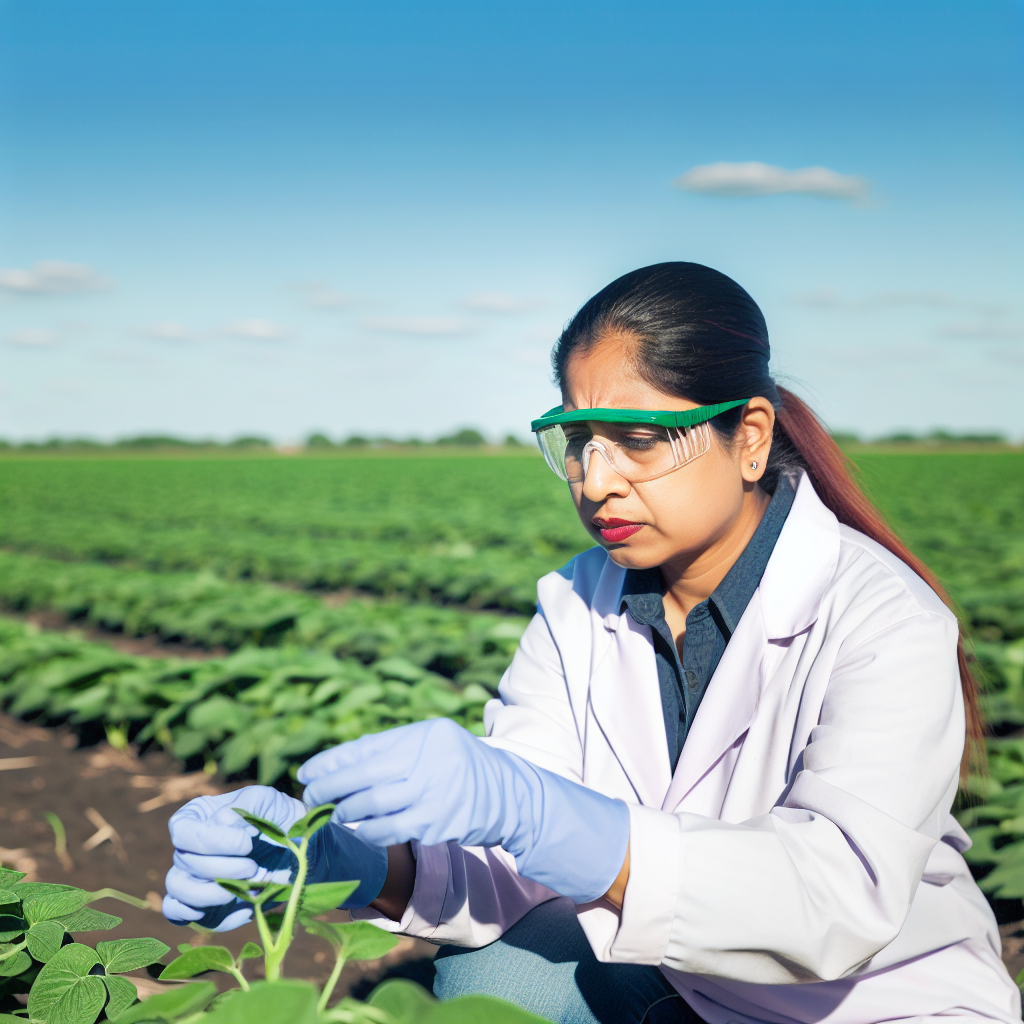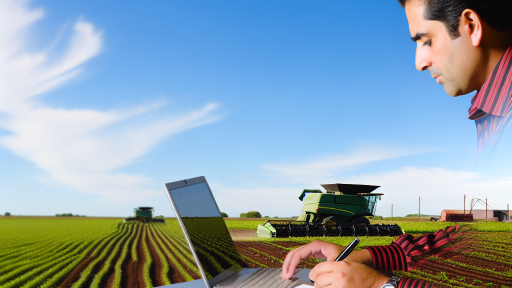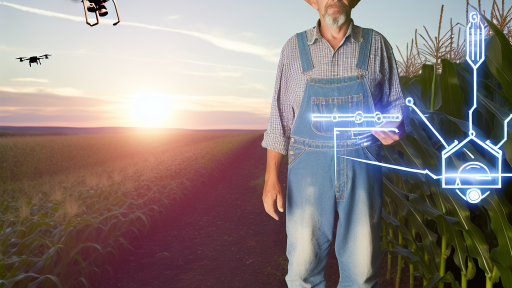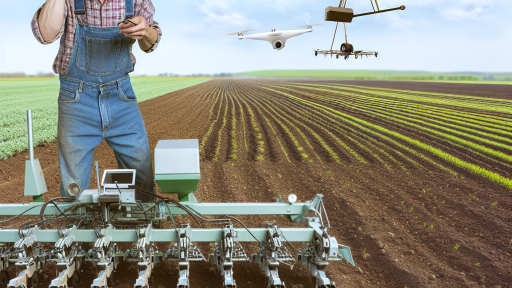Overview of Current Crop Disease Detection Methods
Traditional Detection Techniques
Farmers have long relied on visual inspection to identify crop diseases.
They examine plants for visible symptoms such as discoloration or wilting.
Additionally, farmers use simple tools like magnifying glasses to spot pests.
This approach, however, often results in late detection.
As a result, crops may suffer severe damage before intervention occurs.
Laboratory-Based Testing
Laboratory testing offers a more rigorous method of disease detection.
Farmers send samples to labs for analysis of pathogens.
Techniques such as PCR allow for precise identification of diseases.
Nonetheless, this method requires time and resources.
Farmers may face delays in receiving test results.
Remote Sensing and Aerial Imaging
Remote sensing technology has transformed crop disease detection.
Drones and satellites capture images of crops from above.
These platforms detect stress levels and variations in color.
Farmers utilize this data to monitor large areas quickly.
Moreover, they can identify potential disease outbreaks early.
Transform Your Agribusiness
Unlock your farm's potential with expert advice tailored to your needs. Get actionable steps that drive real results.
Get StartedSmartphone Applications
Smartphone applications have become popular tools for farmers.
These apps use image recognition to diagnose crop diseases.
Farmers can upload photos of affected plants for analysis.
Additional features often provide treatment suggestions.
This accessibility enhances farmers’ ability to make timely decisions.
Integration of Advanced Technologies
Today, technologies like artificial intelligence are gaining traction.
AI analyzes data from various sources to predict disease outbreaks.
This integration fosters a proactive approach to disease management.
As a result, farmers can protect their yields more effectively.
Adopting cutting-edge solutions is essential for modern agriculture.
Impact of Climate Change on Crop Diseases and Detection Needs
Changing Climate Patterns
Climate change significantly alters temperature and precipitation patterns.
These changes facilitate the emergence of new crop diseases.
For instance, warmer temperatures enhance fungal and bacterial activity.
Consequently, farmers confront an increased variety of crop threats.
Increased Crop Vulnerability
As climates become less predictable, crops grow more susceptible to diseases.
This vulnerability stems from greater stress caused by extreme weather.
Moreover, fluctuating conditions hamper the crops’ natural defenses.
As a result, yield losses can escalate dramatically.
Need for Advanced Detection Technologies
With these changes, the demand for effective disease detection intensifies.
Farmers require timely and accurate information on potential disease outbreaks.
Consequently, existing detection methods may become inadequate.
Thus, investment in innovative detection technologies is crucial.
Emerging Technologies in Crop Disease Detection
Advancements in biotechnology are paving the way for enhanced detection.
For example, remote sensing and drones can monitor crop conditions.
Showcase Your Farming Business
Publish your professional farming services profile on our blog for a one-time fee of $200 and reach a dedicated audience of farmers and agribusiness owners.
Publish Your ProfileAdditionally, machine learning algorithms analyze data for early disease signs.
These technologies offer farmers a proactive approach to disease management.
Collaboration and Knowledge Sharing
Successful disease detection depends on collaboration among various stakeholders.
Farmers, researchers, and technology developers must work together.
Sharing knowledge will enhance disease management strategies.
Moreover, it fosters innovation and accelerates technology adoption in agriculture.
Emerging Technologies: AI and Machine Learning in Disease Detection
The Role of Artificial Intelligence
Artificial intelligence significantly enhances crop disease detection.
This technology analyzes large amounts of data swiftly.
It identifies patterns that human analysts may overlook.
Farmers benefit from faster diagnosis of diseases.
Moreover, AI can suggest effective treatment options.
Machine Learning Applications
Machine learning is a subset of AI focused on learning from data.
It continually improves its accuracy over time.
Farmers can use machine learning algorithms for crop monitoring.
These algorithms can detect early signs of diseases.
This proactive approach helps mitigate crop loss.
Image Recognition Technology
Image recognition plays a critical part in disease detection.
Drones and smartphones can capture images of crops.
AI processes these images to identify potential diseases.
Farmers receive immediate feedback on crop health.
This technology aids in making informed decisions quickly.
Data Integration and Analytics
Comprehensive data collection enhances AI’s effectiveness.
Crop health data can merge with weather and soil data.
Integrating these datasets offers holistic insights.
Farmers can adjust their practices according to these insights.
This increases both yield and sustainability in farming.
Case Studies and Real-World Applications
Various farms are already using AI and machine learning tools.
For example, Agritech Innovations has developed an AI platform.
This platform predicts disease outbreaks with high accuracy.
Similarly, GreenField Technologies employs drone technology.
It monitors vast farmland and detects diseases early.
Future Prospects
The future of disease detection looks promising with AI.
Advancements in technology will improve accuracy further.
As more farmers adopt these tools, overall crop health will improve.
Additionally, collaboration among technology developers and farmers is crucial.
Together, they can create tailored solutions for specific crops.
Find Out More: Environmental Impact Of Genetically Modified Agriculture
Remote Sensing Technologies: Drones and Satellites in Agriculture
Introduction to Remote Sensing
Remote sensing technologies are transforming agricultural practices.
Farmers now utilize drones and satellites for crop monitoring.
These tools enhance the precision of disease detection.
Showcase Your Farming Business
Publish your professional farming services profile on our blog for a one-time fee of $200 and reach a dedicated audience of farmers and agribusiness owners.
Publish Your ProfileThe Role of Drones
Drones play a crucial role in modern agriculture.
They offer high-resolution imagery of crops.
This imagery helps identify areas affected by disease.
Moreover, drones can cover large fields rapidly.
Farmers receive timely information to make decisions.
Advantages of Satellite Technologies
Satellites provide a broader perspective on agricultural land.
They collect data over extensive areas consistently.
Satellite imagery reveals trends in crop health over time.
Farmers can analyze these trends for proactive measures.
Additionally, satellites assist in identifying environmental factors.
Integration of Drones and Satellites
Combining data from drones and satellites enhances accuracy.
This integrated approach allows for more comprehensive analyses.
Farmers can pinpoint issues at both macro and micro levels.
Furthermore, advanced software facilitates real-time data processing.
Future Trends in Technology
The future of remote sensing looks promising for agriculture.
Emerging technologies such as AI will further improve analysis.
Farmers will benefit from automation and predictive analytics.
This advancement will lead to more sustainable practices.
Ultimately, it will result in improved crop yields.
Uncover the Details: Streamlining Farm Operations With Automated Machinery
Biological Approaches: Using Plant Immunity for Disease Resistance
Understanding Plant Immunity
Plant immunity plays a crucial role in defending against diseases.
This innate system helps plants recognize pathogens quickly.
Once identified, plants initiate a defense response.
This response includes chemical signaling and cellular changes.
Consequently, resistant plant varieties can withstand infections better.
Genetic Modification Techniques
Genetic modification enhances plant immunity effectively.
Scientists insert specific genes to trigger immune responses.
For example, genes from resistant species can confer benefits.
As a result, modified plants show improved disease tolerance.
Moreover, these techniques can reduce pesticide reliance.
Breeding for Resistance
Conventional breeding remains a valuable tool for disease resistance.
Farmers select plants exhibiting natural resistance traits.
This method leverages biodiversity to enhance crop performance.
By crossing resistant varieties, growers develop stronger lines.
Ultimately, this approach promotes sustainable agricultural practices.
Biocontrol Methods
Biocontrol exploits natural enemies to combat crop diseases.
Beneficial microorganisms, such as bacteria and fungi, offer protection.
These agents can outcompete pathogens or induce plant defenses.
In addition, they support soil health and crop productivity.
Farmers can integrate biocontrol strategies into their practices.
Showcase Your Farming Business
Publish your professional farming services profile on our blog for a one-time fee of $200 and reach a dedicated audience of farmers and agribusiness owners.
Publish Your ProfileFuture Directions
Advancements in biotechnology will shape plant immunity practices.
New techniques will enhance our understanding of plant-pathogen interactions.
Furthermore, precision agriculture will allow targeted approaches.
Ultimately, a combination of methods will maximize effectiveness.
This multi-faceted strategy promises healthier crops and sustainable yields.
Learn More: Smart Irrigation and Precision Agriculture Benefits
The Role of Big Data in Predictive Analysis of Crop Diseases
Understanding Big Data in Agriculture
Big data is revolutionizing agriculture and crop management.
This technology analyzes vast amounts of information quickly.
Farmers can leverage these insights to make informed decisions.
With accuracy, they can predict and mitigate crop diseases effectively.
Data Sources for Predictive Analysis
Various data sources contribute to successful predictive analysis.
Weather data provides critical insights into climatic conditions.
Soil health data assesses nutrient content and pH levels.
Satellite imagery offers visual data on crop health.
Lastly, sensors in fields collect real-time information.
Benefits of Predictive Analysis
Utilizing predictive analysis improves crop health management.
This technology enables early detection of diseases in crops.
Moreover, it optimizes resource allocation and reduces waste.
By applying these insights, farmers can enhance yield and profit.
Case Studies of Successful Implementations
Numerous case studies highlight successful big data applications.
For example, AgriTech Innovations developed a disease prediction model.
This model uses weather patterns and soil data to forecast diseases.
As a result, farmers in the region reported higher yields.
Another success story involves GreenField Analytics.
They employed satellite imagery to identify disease outbreaks.
This proactive approach minimized crop loss significantly.
The Future of Big Data in Agriculture
The future holds even more promising advancements in big data.
With advances in artificial intelligence, predictions will become more precise.
Data integration across platforms will also enhance accuracy.
As technology evolves, farmers will benefit from even greater insights.
Ultimately, this will lead to sustainable farming practices.
Explore Further: Overcoming Challenges In Crop Disease Detection Systems For Farmers

Integration of Disease Detection Technologies in Precision Agriculture
Overview of Precision Agriculture
Precision agriculture optimizes field-level management regarding crop farming.
This approach uses technology to monitor and manage agricultural production.
By analyzing data, farmers can make informed decisions based on real-time information.
Importance of Disease Detection
Early detection of crop diseases is crucial for successful harvests.
Diseases can spread rapidly, causing significant losses if not addressed promptly.
Therefore, integrating disease detection technologies can dramatically improve outcomes.
Cutting-Edge Technologies
Numerous technologies are emerging to enhance disease detection in crops.
Remote sensing and aerial imagery enable farmers to observe crop health from above.
Showcase Your Farming Business
Publish your professional farming services profile on our blog for a one-time fee of $200 and reach a dedicated audience of farmers and agribusiness owners.
Publish Your ProfileMoreover, machine learning algorithms analyze large datasets to identify disease patterns.
Sensor technologies provide real-time monitoring for environmental conditions affecting crops.
Benefits of Integration
Integrating disease detection technologies leads to precise management practices.
This precision reduces the need for preventive pesticide applications.
Consequently, farmers save costs while minimizing environmental impact.
Furthermore, data-driven decisions promote sustainable agricultural practices.
Future Prospects
The future of crop disease detection looks promising with ongoing advancements.
Collaboration among tech firms, researchers, and farmers is vital for innovation.
Additionally, developing user-friendly platforms can ease technology adoption.
As technologies evolve, they will likely become more accessible for all farmers.
Challenges and Limitations of Implementing New Detection Technologies
High Initial Costs
Implementing new crop disease detection technologies often requires significant financial investment.
Farmers may struggle to afford these technologies upfront.
Additionally, ongoing maintenance and operational costs can be high.
Limited Accessibility
Access to advanced technologies varies significantly across regions.
Some farmers may not have the technological infrastructure needed.
This limitation can hinder widespread adoption.
Training and Education Gaps
Farmers and agricultural workers need proper training to use new technologies effectively.
Many lack the necessary skills to operate and interpret results from advanced tools.
This gap in education can lead to underutilization of these technologies.
Resistance to Change
Established farming practices often face resistance from traditional farmers.
Change can be viewed as risky or unnecessary.
Moreover, a lack of trust in new technologies further complicates adoption.
Data Management Challenges
New detection technologies generate vast amounts of data.
Managing and analyzing this data can overwhelm farmers.
Furthermore, insufficient data management systems can lead to ineffective decision-making.
Environmental Variability
Crop diseases can vary significantly based on environmental conditions.
These variables can affect the accuracy of detection technologies.
As a result, farmers may encounter inconsistent results.
The Role of Genetic Engineering in Disease Resistance
Advancements in Genetic Techniques
Genetic engineering revolutionizes crop disease resistance.
New techniques, like CRISPR, allow precise modifications.
Researchers can enhance specific traits in plants.
This leads to robust varieties more resilient to disease.
Benefits of Genetically Engineered Crops
Genetically engineered crops decrease the reliance on pesticides.
These crops require fewer chemical inputs for protection.
Farmers experience increased yields and reduced losses.
Moreover, they can address food security challenges effectively.
Addressing Challenges and Concerns
Despite benefits, some challenges persist in public perception.
Consumer concerns about safety and environmental impact remain.
Education is crucial to mitigate these concerns effectively.
Transparent labeling and communication enhance public trust.
Showcase Your Farming Business
Publish your professional farming services profile on our blog for a one-time fee of $200 and reach a dedicated audience of farmers and agribusiness owners.
Publish Your ProfileThe Future of Crop Improvement
Future trends signal more innovative genetic techniques emerging.
Scientists will continue discovering new ways to enhance traits.
Collaboration between public organizations and private companies will thrive.
This partnership can accelerate the development of superior crops.
Additional Resources
Enhancing precision agriculture: A comprehensive review of …
USDA Science and Research Strategy, 2023-2026: Cultivating …




